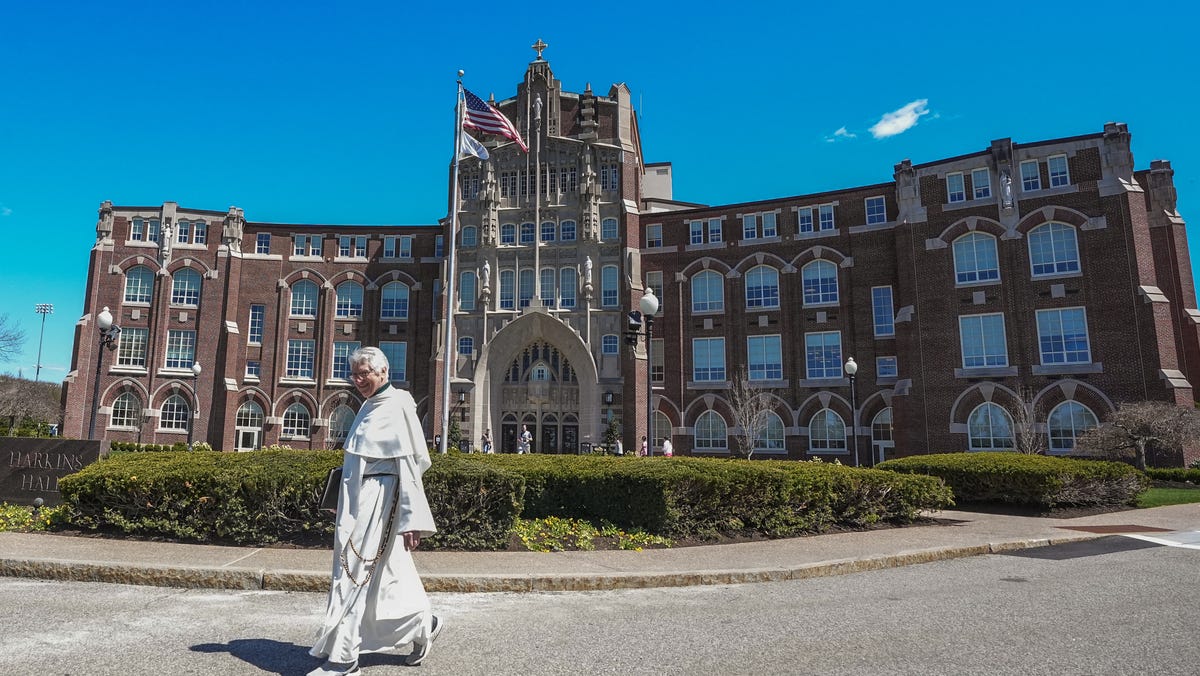Nebraska
Explore the World of Willa Cather in Her Nebraska Hometown
/https://tf-cmsv2-smithsonianmag-media.s3.amazonaws.com/filer_public/16/50/1650abaa-edb2-4d34-92bf-16984b7ae96d/julaug2023_j06_willacather.jpg)
Six miles outside Red Cloud, Nebraska, the blackness is absolute. Before sunrise the moonless stars sizzle and hum high above the prairie. Down here—stillness. Even the wind isn’t up yet. And it’s too dark to see your own boots.
Then the light sneaks in, a single gray-scale brushstroke low on the horizon. The next deeper and richer than the last. In town, dawn silhouettes the rooflines and the chimneys across the street an hour before it casts a shadow. Then all at once a new day tangles itself in the trees.
Folks work early here, and late, and when harvest comes to this part of Nebraska the big trucks rumble through town at every hour. Down at the depot and out at the co-op, mountains of grain wait to be shipped or siloed. The cattle stir in the lots, the hens bob and scratch in the yards, and ranchers and farmers, pulling on their jackets, finish their second cup of coffee on the way out the door.
You can still see this Nebraska, still know it, as it was first encountered by its most famous resident, the novelist Willa Cather, who came west with her family from Virginia in 1883, when she was 9 years old. They were sheep ranchers and lived on a small spread 12 or so miles outside Red Cloud. She fictionalized her nighttime arrival there in My Ántonia, her beloved novel from 1918.
Cautiously I slipped from under the buffalo hide, got up on my knees and peered over the side of the wagon. There seemed to be nothing to see; no fences, no creeks or trees, no hills or fields. If there was a road, I could not make it out in the faint starlight. There was nothing but land: not a country at all, but the material out of which countries are made. No, there was nothing but land. … I had the feeling that the world was left behind, that we had got over the edge of it, and were outside man’s jurisdiction.
This year marks the 150th anniversary of Cather’s birth. One of our greatest novelists, she helped invent the literature of American modernism. She wrote a dozen novels; scores of novellas, short stories and poems; and hundreds of magazine and newspaper pieces. Many of the novels feature a fictionalized Red Cloud by another name—Hanover, Black Hawk, Sweet Water—including her three fame-making “prairie novels,” on which her reputation largely rests: O Pioneers!, published in 1913; The Song of the Lark, 1915; and My Ántonia, arguably her best and most studied book, a perfection of form and theme, of purpose and personal history.
Cather as a child, circa 1882.
Photo by Ensminger, c. 1937, Philip L. and Helen Cather Southwick Collection, Archives & Special Collections, University of Nebraska–Lincoln Libraries
A studio portrait of Willa Cather taken by Nickolas Muray in the early 1920s.
Philip L. and Helen Cather Southwick Collection. Archives & Special Collections, University of Nebraska–Lincoln Libraries.
/https://tf-cmsv2-smithsonianmag-media.s3.amazonaws.com/filer_public/97/e7/97e712a0-8949-4215-bcbc-eb4f08f9b40f/julaug2023_j14_willacather.jpg)
We mostly read Cather too soon, in high school, before we know enough about anything to know how good she is. Or too late, in graduate school, when we shrink her work to fit the cultural or political pigeonholes of the time. It’s easy to forget what a fine storyteller she is. And what a remarkable observer, perhaps the best American writer of place—of landscape as character and destiny—we’ve ever had.
However small you think Red Cloud is going to be, it’s smaller—about 1,000 souls scattered across a modest grid of streets, schools, homes and businesses, where U.S. Highway 136 intersects U.S. Highway 281 in south-central Nebraska. Surrounded by farms and ranches, it is a tiny lifeboat on a rolling ocean of grass.
When Cather was growing up, the town probably wasn’t much different than it is now. A little bigger. Home to at least 1,800 people, many of them immigrants. Busier maybe, thanks to the railroad and the work it created. Enough of a downtown that an opera house—the local theater—was built here in 1885. The Cathers moved into town around that same time, to a house on Third Avenue and Cedar Street. Willa’s father opened a real estate, insurance and loan business, and she started attending the town school.
The oldest of seven children, Willa was widely known. Friendly, avid, curious, the smartest girl in town, she was an insatiable reader and borrower of books. She loved theater, dramatics, costumes. She read everything and asked questions of everyone. She learned biology thanks to the town doctors, whom she sometimes accompanied on their rounds.
Today, at the crossroads of Routes 281 and 136—in town they’re called Webster Street and Fourth Avenue—and running a few hundred feet in every direction, are the picturesque brick pavers that give the town its charm and the truckers their back spasms.
“I felt that the grass was the country, as the water is the sea,” she wrote of the “copper-red” prairie in My Ántonia.
Calla Kessler
/https://tf-cmsv2-smithsonianmag-media.s3.amazonaws.com/filer_public/b6/a7/b6a70795-9851-4a7d-a610-5300d85b2c5c/willa_058.jpg)
This was Pawnee country, but Red Cloud was named for the famous Oglala Lakota chief. A Sioux leader and a fierce fighter, he was widely admired. One of those admirers, Silas Garber, founded the town in 1871. He built himself a beautiful red-brick-and-sandstone bank and was later elected governor of Nebraska. The bank is three doors over from the local newspaper, founded in 1873, the Red Cloud Chief. Janice Hartman, the editor, is happy to tell you what’s going on in town if you stop by to say hello.
Next door is the post office, a Federal Moderne looker with three frontier murals in the lobby painted by WPA standout Archie Musick. One of them, titled Moving Westward, a passive, pleasant depiction of Indigenous people leaving their land, remains an uncanny reminder of our nation’s founding amnesia.
Red Cloud’s post office, built in 1939. The building features murals by WPA artist Archie Musick, a student of the painter Thomas Hart Benton.
Calla Kessler
The Corner Nook coffee shop in Red Cloud. Cather longed for her hometown, preferring it to “any of the beautiful cities in Europe,” she wrote in 1945.
Calla Kessler/https://tf-cmsv2-smithsonianmag-media.s3.amazonaws.com/filer_public/33/b3/33b30812-b504-481e-9279-16d928a60d77/julaug2023_j12_willacather.jpg)
/https://tf-cmsv2-smithsonianmag-media.s3.amazonaws.com/filer_public/b7/c7/b7c7f526-0aa8-446e-9d0a-4c6021df7449/julaug2023_j11_willacather.jpg)
Across the street is the Village Pharmacy. Ever since the coffee shop in the old hotel closed, this is where the morning talkers meet to chop up current events, discuss local politics and gossip. Fifteen cars and trucks out front by 9:15 a.m. Twenty men at two round tables in field jackets and seed company snapbacks. All different, all the same. Like those old boys on the Dutch Masters cigar box, but outfitted by Carhartt.
Lately talk is about the new jail. It’ll cost more than $6 million and require a tax hike.
“Pretty fancy jail for a little place like Red Cloud,” goes one line of coffee cup argument.
“Town is gonna grow,” goes another.
“If we had a Walmart or a truck stop, maybe,” goes a third.
Over at the Community Center—across the street from Cather’s childhood home at Third and Cedar, currently undergoing renovations—the sheriff made a pitch for a variance to allow an eight-foot setback on the north side.
Juan’s Bar and Grill. The taco and burger joint is two blocks from Cather’s childhood home and two doors from the Red Cloud Chief newspaper, published since 1873.
Calla Kessler
/https://tf-cmsv2-smithsonianmag-media.s3.amazonaws.com/filer_public/c2/59/c259d503-8f5a-4caf-8694-8f0a0ca0033f/julaug2023_j13_willacather.jpg)
“I’m not here for all you guys to approve or disapprove the building,” he said. “Just the setback.” The ayes were unanimous for the setback and the variance, for the bigger parking lot and the sally port, but when the vote on the jail came up last November, voters killed the initiative.
The town library has its own small Willa Cather section. Ask Terri Eberly the librarian to show you the first editions.
A couple of blocks away is the Palace steakhouse, home of a B+ ribeye and an A+ collection of Def Leppard memorabilia. Half a block from that is Juan’s Bar and Grill, which has an A+ cheeseburger and fries. There’s a giant cooler behind the bar for iced shots of Jägermeister and peach schnapps, and if you hang around long enough, you’ll hear more about the jail, and about those “goddamned cobbles,” and about a local farmer whose combine was forever starting fires.
If you’re lucky, come harvest time, you’ll spot the sign out front of the insurance office reading “Free Farm Lunch.” There are tables set up and coolers with drinks and potato salad and coleslaw and warming trays with burgers and hot dogs. Folks are so busy during harvest they barely have time to eat, much less cook. First hour that sign was up, the insurance folks gave out more than 100 lunches. A kindness that’s also good advertising. There’s a friendly new grocery storefront up the street, too, doing nice soups and sandwiches.
Willa Cather looms large in her hometown of Red Cloud, Nebraska, where her namesake foundation offers tours of the landscape that inspired her literary excellence.
Calla Kessler
/https://tf-cmsv2-smithsonianmag-media.s3.amazonaws.com/filer_public/48/bc/48bc52f7-0674-4fd6-89eb-4aecf0fca0ba/julaug2023_l01_toc.jpg)
And right in the middle of all this is the Willa Cather Foundation and its gleaming National Willa Cather Center. The best-looking buildings on the block. Wonderfully restored white-and-antique-green-trimmed red-brick storefronts—20,000 square feet of public museum, archive, research center, classroom, bookstore, art gallery and performing arts center. In town and out of town the organization owns, manages and offers tours of nearly 50 properties.
It draws scholars and volunteers from all over the world. It is a powerful cultural and economic engine for the region. Cather tourism accounts for roughly $1.3 million spent in Webster County every year.
The Cather family home can be rented as a guest house. The author’s bedroom is called “Frankfort,” the name she gave the town in One of Ours.
Calla Kessler/https://tf-cmsv2-smithsonianmag-media.s3.amazonaws.com/filer_public/ee/54/ee545ad0-2736-46de-afe9-fdd260b8529a/julaug2023_j10_willacather.jpg)
Come to Red Cloud. Take the Town Tour along these tree-lined streets and walk the place end to end. Take the Country Tour, a grand, dust-raising circuit northwest out of town on string-straight county roads. The prairie of Cather’s youth is long since fenced, and the cell towers and wind farms skylining the horizon keep you firmly in the present, but the ranches and the churches and the cemeteries and the opera house over in Bladen, where they held the funeral for Cather’s cousin, Grosvenor P. Cather, killed in France during World War I, are still there.
See the Pavelka Farmstead, home of Anna Pavelka, the Bohemian immigrant girl who was hired to work for the Cathers’ neighbors and inspired My Ántonia, now restored and preserved as an attraction. Walk the site of the long-gone first Cather homestead, the one to which Willa was driven in the back of that wagon. It is both less and more than you expect, a modest hollow in the hillside just up from a narrow creek bottom under a limitless vault of ultramarine. Even a casual Cather fan, imagining her there as a little girl, feet planted, looking up, is moved by the thought.
Walk the Willa Cather Memorial Prairie, just out of town, 612 acres of native shortgrass rolling away to the sky and down to a stand of cottonwood. Thistle and sedge, buffalo currant and sunflower. You can hike every foot of it. Birds everywhere. Cattle. That sky.
Like a lot of plains towns, Red Cloud has been hollowed out the last half-century. But there’s hope that broadband and remote work and the low cost of living might bring young folks home to new opportunities.
So the Cather Center is also helping plan Red Cloud’s economic redevelopment, including construction of a new 26-room hotel and restaurant at the crossroads. From which arises some tension between the residents and the center.
Left, the Corner Nook. The block across the street includes the opera house, which Cather loved, restored in 2003, and the National Willa Cather Center.
Calla Kessler
/https://tf-cmsv2-smithsonianmag-media.s3.amazonaws.com/filer_public/b6/12/b612eb87-42bd-46a0-a9d2-ec7b62dd537f/julaug2023_j05_willacather.jpg)
Things seem split along predictable lines—conservative ranchers and farmers versus liberal academics—but they aren’t. The truth is a lot more complicated. Everyone here needs everyone else. But how to compromise? How to keep the lifeboat afloat? Those pavers sure are pretty in front of the Cather Center, and in the brochures, but for the farmers and the truckers and the implement dealers, they’re a spine-cracking 100-yard speed bump between here and everywhere you have to go. Who decides what to keep, and what to throw over the side?
In 1890, Willa went to Lincoln to attend the University of Nebraska, hoping to become a doctor. Instead, one of her instructors submitted an essay she’d written to the Nebraska State Journal, and she became a writer. She moved to Pittsburgh in 1896 to work as a magazine editor and spent ten years there. It’s where she met Isabelle McClung, one of two important women in her life.
She left for New York City in 1906 and became the managing editor of McClure’s, a magazine of renown. Once there, she moved in with Edith Lewis, a writer and editor she’d met in Nebraska in 1903, and with whom she lived the rest of her days.
The reading room at the New York Society Library in Manhattan. Cather was a fixture there for 20 years, drawing on its archives to research her novels.
Calla Kessler A collection of books by Cather at the library. In an essay honoring her, Truman Capote recalled how a chance 1942 encounter at the library changed his life.
Calla Kessler
/https://tf-cmsv2-smithsonianmag-media.s3.amazonaws.com/filer_public/9f/f4/9ff43f17-c990-4a61-8159-776248b236e4/julaug2023_j02_willacather.jpg)
/https://tf-cmsv2-smithsonianmag-media.s3.amazonaws.com/filer_public/ba/82/ba82f90b-0eda-4666-b13c-c54fa82d4824/julaug2023_j01_willacather.jpg)
For more than 20 years they lived downtown, mostly in Greenwich Village, among the reds and the radicals, the poets and the painters and the proto-
beatniks of that age. In 1932 she and Lewis moved uptown to Park Avenue. From the artists of Washington Square to the dowagers and doormen of the Upper East Side was a cultural distance as great as any trip from Nebraska to New York.
But Cather loved it there and wrote about her prairie West from her Upper East Side.
Still, she went home for regular visits to Red Cloud. The second Cather home—the one at Sixth and Seward her parents bought in 1903, where she’d stay when visiting from New York—can now be booked as a guest cottage. It’s a charming house on a quiet corner, very pretty, with lots of room. After the Cathers passed on, it served a number of years as the town’s hospital.
Washington Square Park in Greenwich Village. Cather’s first New York apartment faced the arch. Later, she lived three blocks north.
Calla Kessler/https://tf-cmsv2-smithsonianmag-media.s3.amazonaws.com/filer_public/3f/d5/3fd54c7f-ac3e-4629-9e39-a26ec7b63bcf/julaug2023_j03_willacather.jpg)
A writer from the East, generally suggestible, might have heard stories about guests who felt a certain, um, presence in the house. Staying there himself, he might have felt the hair rising on the back of his neck. More than once. Might have felt a sudden … chill. An electric tingle of the backbone. A sense in the late afternoon of a shadow at the top of the stairs. Might have heard the old house settle and groan. Might even have heard those stairs creak. A writer from the East, suggestible, might have spent the whole week sleeping on the living room sofa, every light blazing in every room.
That’s what some folks say.
On Friday night, the high school football game is an island of light in a sea of darkness. You can’t miss it. Stand anywhere and you’ll know where you’re going—just look for the brightness above the trees. The stands are full, and even a stranger recognizes the faces he’s been seeing all week.
In Red Cloud they play the six-man game—small towns have small teams—and the relative lack of defense means the scores often rise like a multiplication table. By the third quarter it’s 56-7.
Cather loved football and wrote about it more than once. Perhaps the best known of these pieces, written in 1894 while she was an undergraduate, warns of the softening of our young men and compares football to … the Norman Conquest. “It is a game of blood and muscle and fresh air,” she wrote. “It renders distasteful the maudlin, trivial dissipations that sap the energies of the youth of the wealthier classes.”
Imagine Nebraska seen from space on a Friday night in autumn and it is an archipelago of dazzling emeralds bright with small-town passions, affections and devotions.
We locate Cather too much in the past. It’s an easy mistake to make. Maybe it’s the photos. On book jackets, in the archives. All that black-and-white stiff-necked rectitude, the round face and level gaze, the high collar, the velvet and satin of a distant century, the hat—those hats!—flat, drab, lifeless. A rubbing from antiquity.
But on display at the Cather Center, the gloves, the hats, the pins, the dresses, the cloaks all vibrate with color, luscious and deep, turquoise and imperial purple and rich dove gray, a lively riot, a declaration of life and purpose and style. All her life Willa Cather had style.
The Willa Cather Memorial Prairie preserves 612 acres of never-plowed grasses, flowers and other plants. Visitors can explore nearly two miles of trails.
Calla Kessler
/https://tf-cmsv2-smithsonianmag-media.s3.amazonaws.com/filer_public/6f/89/6f8910e5-fbb6-4222-88dc-09e1f45b7ba4/julaug2023_j07_willacather.jpg)
See those colors and you begin to see the girl who ran through these fields and these wide streets, cheeks flushed, busy with life, interested in everything, the girl who looked out from her bedroom window, the room with the steep ceiling pitch and that rose-patterned wallpaper, and saw not just the house across the street but a whole world waiting for her. And whole worlds waiting for her to create.
In Red Cloud, Willa Cather is alive.
Cather’s late work, like the early work, wrestled with death and ambition and longing. Those were always the stakes. Her realism forever tempering her optimism.
She died on April 24, 1947, at age 73. The cause of death was listed at the time as cerebral hemorrhage. But recent scholarship revealed a breast cancer diagnosis in 1945 and a mastectomy the following year. By the time she died, the cancer had spread to her liver. She is buried next to Lewis in New Hampshire, where they spent their summers and falls.
Cather tourism draws more than a million dollars in revenue annually, but agriculture dominates the rural hamlet’s economy and way of life.
Calla Kessler
/https://tf-cmsv2-smithsonianmag-media.s3.amazonaws.com/filer_public/b1/24/b1249b9f-4673-47c4-8644-1e71f0ebe463/julaug2023_j09_willacather.jpg)
The assessment and reassessment of her books will go on. The literary canon is dynamic, a stock market in constant motion—you’re up and you’re down and sometimes you come off the board entirely. One of Ours, her Pulitzer Prize-winning 1922 novel about a small-town soldier gone off to fight and die in the Great War, which Ernest Hemingway famously derided for the inauthenticity of its battle scenes, is now celebrated as a nuanced portrait of self-doubt and ignoble sacrifice. (Hemingway missed the point. For all his wised-up he-man fatalism, he still wrote war as a kind of glorious horror. Cather never saw glory or redemption in it, only waste. Of the two, she saw that truth more clearly.) And some readers lately think Lucy Gayheart, from 1935, about the tangle of inspiration and doomed love, may be her best, thanks to its romantic subtlety and the complexity of its construction.
On the other side of the ledger, Toni Morrison, in Playing in the Dark, her 1992 monograph about race in fiction, politely eviscerated Cather’s final novel, from 1940, Sapphira and the Slave Girl. Set in Virginia before the Civil War, it aims to tell truths about sex and marriage and race, but it is instead an inventory of Cather’s own blind spots, for which no correction or excuse can be made. Fair’s fair.
Still, a century ago, when Henry James and Edith Wharton read like the last of a passing age, Cather was the world to come. Her uncluttered prose was an answer to purple Victorian filigree, and her honesty about pioneering’s costs dismantled the oversimplified pieties of life on the prairie. She is now so revered that this summer her statue was unveiled at the United States Capitol, one of two figures representing the state of Nebraska.
Come to Red Cloud. You’ll find everything there is to know of Willa Cather. You’ll find her along these trim streets, in the lots and the parlors and the churches, in the meadows and the fields, in the perfections of nature and the imperfections of human nature. Look for her out past the depot, over the tracks and across the bridge, up that last long hill. Look for her at sunset on the prairie.
Red Cloud Cemetery, the resting place of Cather’s parents, Charles and Mary, and numerous Nebraskans who inspired fictional creations.
Calla Kessler
/https://tf-cmsv2-smithsonianmag-media.s3.amazonaws.com/filer_public/8f/d3/8fd375d1-4151-4f57-84a7-401636c7959f/julaug2023_j04_willacather.jpg)
Here, along that untroubled horizon, in the shimmering July heat or the howling January cold, in the communion of little bluestem and primrose and switchgrass, in the groves of ash and cottonwoods, you will find her.
Yes. You would know her here.
Recommended Videos

Nebraska
Micah Mazzccua not officially off Nebraska football team despite rumors

It’s a testament to the Matt Rhule era of Nebraska football that off the field, the program has been relatively drama free. However, bature abhores a vacuum and that might be there has been one soap opera around this team this fall and that’s been the “will he or won’t be” of Micah Mazzccua sticking on the roster for the entire season.
Earlier this weekend, it seemed as if the conclusion was that he was already off the team. There were people seeing him taking a flight going in the opposite direction of the rest of the Huskers. When that’s happening the day before game day, it’s never seen as a good thing.
However, after the Nebraska football team’s 28-10 win over Purdue on Saturday, head coach Matt Rhule said in no uncertain terms that Mazzccua is not off the team. While that was an interesting nugget, it’s likely just going to keep the soap opera going. At least for one more day.
Rhule added he’ll shed more light on the situation during his Monday afternoon press conference. Adding once again he’s not off the team, he also said the transfer offensive lineman is “not with them” right now.
All of this new drama comes a week after things with Mazzccua seemed very fluid. He was ruled out of the Northern Iowa game at the last minute. Then Rhule made it clear he wasn’t hurt.
After that game, he said the former Florida Gator and Baylor Bear would not play against Illinois. Something then changed and he was available but not starting. He was seen warming up against Illinois but didn’t get in the game.
Hopefully, when Monday rolls around, this particular situation will make some more sense and it won’t be the talk of Nebraska football every single week.
Nebraska
Harris, Democrats Spending Large Amounts of Money in Nebraska


In a very tight national election, seemingly, every electoral vote is necessary to secure the win for presidency in November. Perhaps that’s the reason for the Harris campaign to spend amounts of money not seen since Obama’s 2008 campaign in Nebraska’s 2nd congressional district- notably including Omaha.
Kamala Harris and Democratic groups have spent more than $5 million in the district since she entered the race on July 23, and have more than $6 million in ad time reserved through Election Day, Nov. 5, according to the media-tracking firm AdImpact. Former President Donald Trump’s campaign, on the other hand, had spent only about $95,000 on advertising in the state and had reserved roughly $6,800 through Nov. 5.
Trump and Republican allies had sought another route to victory, namely to persuade the Republican-dominated Legislature to make Nebraska a winner-take-all contest instead of awarding its Electoral College votes by congressional district. Maine is the only other state that awards its votes that way.
Lacking the votes in Nebraska’s unicameral Legislature however, Republican Gov. Jim Pillen said he would not call a special session to attempt the change.
For Nebraska’s 2nd District to break the tie in the race for the winning majority of 270 Electoral College votes, Trump would have to win all Republican-leaning states plus Arizona, Georgia, Nevada and North Carolina. He would also have to win Maine’s 2nd Congressional District, which he won in 2020, while losing the state overall.
Nebraska
Penalties, Punts and Pitiful Placekicking Precede the Huskers’ Pounding of Purdue with Proficient Production

On a cool and cloudy day in West Lafayette, the Nebraska Cornhuskers rebounded from an anemic first half to soundly defeat the Purdue Boilermakers 28-10 and move to 4-1 on the season. It was an unusually ugly first half as the two teams combined for four missed or blocked field goals, seven punts, going 1 for 12 on third down conversions and committing 129 yards in penalties. In fact, at intermission, Purdue had 90 yards in penalties and just 89 yards of total offense. They had four punts to go with just five pass completions. The Huskers crossed the Purdue 40-yard line on all six first half possessions and racked up 210 yards of offense without scoring a point. Including the end of the Illinois game, it was eight straight possessions by Nebraska inside the other team’s 40 without points. It was a game that deserved to be on Peacock so that a limited viewership had to witness the ineptitude.
The second half began with Purdue consuming 8:08 of the third quarter clock before John Bullock made an impressive stop on third and short to force a Boiler trey. The Huskers then scored on their next three possessions on touchdown drives of 70, 63, and 57 yards, while the defense forced two 3 and outs with Purdue netting -7 and then -1 yards. Purdue’s next drive resulted in a 29-yard pick six by Bullock and at 28-3, the rout was on. It was the Colorado game in reverse in that the Huskers scored all their points after intermission instead of before.
The teams combined for 24 penalties totaling 259 yards. Purdue compiled 165 yards in penalties with every defensive penalty being at least 10 yards. They committed five pass interference penalties as they could not contain Isaiah Neyor, Jahmal Banks, or Heinrich Haarberg. Nebraska had its share of the laundry as well, including an absolutely atrocious offensive pass interference penalty on Thomas Fidone who actually avoided contact with the defender. The flag wiped out a 22-yard touchdown by Rahmir Johnson in the second quarter. The nonsense finally culminated with a fourth quarter 10-yard holding penalty on Jahmal Banks that prompted Matt Rhule to slam his headset to the ground incurring an additional 15-yard personal foul. At that point, I didn’t blame Coach Rhule as the Big Ten officials make middle school referees look like professionals. Facing 2nd and 29, Dylan Raiola completed a pass to Emmett Johnson that picked up 27 yards plus another 15 tacked on for a facemask. The Huskers scored two plays later.
The Blackshirts held the Boilers to 50 yards rushing and 174 yards passing. Purdue managed a consolation touchdown against reserves with 1:29 left in the game, but the defense has now held four of five opponents to 10 points or less this season. Nebraska totaled five sacks in the victory, its second-highest total of the season (six vs. Colorado) and recorded nine tackles for loss. Saturday was the second opponent Nebraska has held scoreless in the first half (Colorado) and the defenders have allowed just three points in the second quarter this season. Nebraska is one of only seven teams who has not allowed a rushing touchdown this season and including last season, the Huskers have not allowed a rushing touchdown in 10 of their past 12 games.
Ceyair Wright, filling in for Tommi Hill, had another outstanding game co-leading the defense with five tackles and two pass breakups. Mikai Gbayor also had five stops in the game. James Williams with 2 sacks and M.J. Sherman with 1.5 sacks both set career highs in that category on Saturday. Williams’ two sacks are the most by a Husker this season and the most since Nash Hutmacher had 2.5 sacks against Northwestern last season. Ty Robinson added another sack and Kai Wallin shared a sack with Sherman. Bullock, Mario Buford, Jimari Butler, and Keona Davis all chipped in with tackles for loss. The pick-six by Bullock was his first career interception and was heartily celebrated by his teammates as the pick was a just reward for a guy who has been working his butt off on defense. It marked Nebraska’s second interception for a touchdown this season (Tommi Hill vs. Colorado) and it marks the first time since 2017 that Nebraska has had two pick-six TDs in a season. In finishing +1 in turnovers Saturday, Nebraska improves to +5 on the season with the Huskers outscoring opponents 31-0 in points off turnovers.
Dylan Raiola finished 17-of-27 for 257 yards and a touchdown, as he connected with eight different receivers. He has also thrown at one touchdown pass in all five games this season. He was sacked just once as the Huskers started their third string left tackle, Gunnar Gottula, following the injury to Turner Corcoran last week. The offensive line generally gave Raiola plenty of time in pass protection but struggled in the first half with run blocking as the Huskers only had 49 yards rushing on 13 attempts. They seemed to improve as the game wore on, though, finishing with 161 yards on the ground on 31 carries yielding two touchdowns.
Senior receiver Jahmal Banks caught a 6-yard touchdown in the third quarter for Nebraska’s first points. It marked his second touchdown of 2024 (UTEP) and his 15th career receiving touchdown. Banks finished the day with five catches for 82 yards and has 13 receptions the past two weeks. Thomas Fidone had 3 catches for 39 yards and Jaylen Lloyd nabbed one grab for 25 yards.
Jacory Barney Jr. led Nebraska with 66 yards rushing on four carries, including a career-high 31-yard run and a 25-yard touchdown run. Barney entered the game with 38 yards rushing. He also had two catches for 28 yards. His speed is electric and has to be a challenge to defend. Emmett Johnson totaled 98 all-purpose yards (50 rushing, 48 passing) on just 10 touches. Johnson’s 48 receiving yards were a career high (43 vs. UNI) while his 27-yard reception was also career long. Johnson seems to spark the team when he enters the game as he has a wiggle and a burst that nets solid gains. Dante Dowdell (9 carries for 21 yards) was stuffed more often than not but got a 1-yard fourth down fourth quarter touchdown to put the Huskers up 14-3. The play was aided by a great block by Barret Liebentrit who nailed two defenders on the edge.
Special teams were a disaster and if not improved will cost the Huskers at least a game or two down the stretch. With Tristan Alvano still nursing a groin injury, back-up kicker John Hohl missed his first field goal attempt from 42-yards. The second and third attempts were blocked after bad snaps that holder Brian Buschini barely got set. Camden Witucki replaced Aidan Flege as the snapper after the first block, and at least managed decent snaps on four subsequent extra point attempts. The errant snaps may have cost us the game last week and must be maddening for a coaching staff that has to consider keeping the offense on the field no matter the fourth down yardage. Blockers on punt returns are whiffing on blocks and gunners on punt coverage are getting lost in the end zone rather than downing punts inside the 5-yard line. Punter Brian Buschini did manage to get two of three punts inside the 20 and had touchbacks on four of five kickoffs while making three tackles on punt and kick coverage.
After last week’s gut punch loss that had presented so many opportunities to win, you take any road win you can get in the Big Ten. The Huskers likely gained a bit of confidence with their second half performance against a mediocre Purdue team as Nebraska has yet to play a four-quarter game. In his presser, Coach Matt Rhule stated, “It might not be for everybody, but we are just a growing team.” He has continued to stress the long game of growth and maturity. Kids make mistakes. It’s up to the coaches to help them learn and develop. It will certainly help if the Huskers find that four-quarter game next Saturday as the undefeated and likely ranked Scarlet Knights from Rutgers make their appearance in Memorial Stadium. Hopefully, the team can take the next step toward bowl eligibility. Go Big Red!!!
MORE: Tad Stryker: Ground Game Grit
MORE: I-80 Club After Dark: Nebraska is 4-1 After a 28-10 Win Over Purdue
MORE: The Turning Point: Nebraska at Purdue
MORE: Adam Carriker Gut Reaction: Nebraska Football’s Ugly, Bounce-Back Win Over Purdue
MORE: WATCH: Nebraska Football Coach Matt Rhule Postgame; Cornhuskers Top Boilermakers
Stay up to date on all things Huskers by bookmarking Nebraska Cornhuskers On SI, subscribing to HuskerMax on YouTube, and visiting HuskerMax.com daily.
-

 News1 week ago
News1 week agoVideo: Who Are the Black Swing Voters?
-

 Politics1 week ago
Politics1 week agoDem lawmakers push bill to restore funding to UN agency with alleged ties to Hamas: 'So necessary'
-

 News1 week ago
News1 week agoFour killed, dozens injured in Alabama shooting
-

 News1 week ago
News1 week agoElection 2024 Polls: Florida
-

 News1 week ago
News1 week agoMoney for cutting-edge climate technology could dry up in a second Trump term
-

 World1 week ago
World1 week agoCritics slam landmark EU competitiveness report as 'one-sided'
-

 Politics1 week ago
Politics1 week agoSecret Service protection bill passes House unanimously after Trump assassination attempts
-
/static.texastribune.org/media/files/5e5395400eb1f412fb6d97a439483caf/SpaceX%20Brownsville%20MGO%2005.jpeg)
/static.texastribune.org/media/files/5e5395400eb1f412fb6d97a439483caf/SpaceX%20Brownsville%20MGO%2005.jpeg) News1 week ago
News1 week agoCards Against Humanity says in new lawsuit that SpaceX has destroyed some of its South Texas property




















